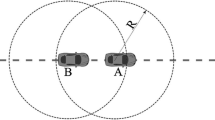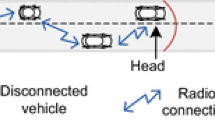Abstract
Modeling and analysis of communication link duration in vehicular ad hoc networks (VANETs) is crucial as it directly affects many performance metrics such as packet delivery ratio, throughput and end-to-end delay. In this paper, we investigate the properties of communication link duration in one-dimensional VANETs for different fading channel conditions. We employ a stochastic microscopic mobility model that takes into account time dependence of the inter-vehicle distance. A discrete-time finite-state Markov chain with state dependent transition probabilities is used to model the inter-vehicle distance. The presence of fading channel conditions will introduce fluctuations in the received signal power. Even when the inter-vehicle distance between a given pair of vehicles is less than their transmission range, poor channel conditions may result in link failure. A modified distance transition probability matrix is derived to describe the combined effects of relative velocity among a pair of vehicles, link failure due to outage, and inter-vehicle distance. The probability distribution of the communication link duration is derived from the modified distance transition probability matrix. The analytical results obtained from the model are validated by extensive simulation results.












Similar content being viewed by others
References
J. J. Blum, A. Eskandarian, and L. Hoffman, Challenges of intervehicle ad hoc networks, IEEE Transactions on Intelligent Transportation Systems, vol. 5, no. 4, pp. 347–351, 2004.
S. Zeadally, R. Hunt, Y.-S. Chen, A. Irwin, and A. Hassan, Vehicular ad hoc networks (vanets): status, results, and challenges, Telecommunication Systems, vol. 50, no. 4, pp. 217–241, 2012.
G. Karagiannis, O. Altintas, E. Ekici, G. Heijenk, B. Jarupan, K. Lin, and T. Weil, Vehicular networking: A survey and tutorial on requirements, architectures, challenges, standards and solutions, IEEE Communications Surveys and Tutorials, vol. 13, no. 4, pp. 584–616, 2011.
ASTM-E2213, standard specification for telecommunications and information exchange between roadside and vehicle systems 5GHz band dedicated short range communications (DSRC) medium access control (MAC) and physical layer (PHY) specifications, american society for testing and materials (ASTM) std. 2002.
IEEE 802.11p, amendment to standard for information technology- telecommunications and information exchange between systems-local and metropolitan area networks-specific requirements part 11: Wireless lan medium access control (MAC) and physical layer (PHY) specifications-amendment 7: Wireless access in vehicular environment, IEEE std. IEEE 802.11p, 2010.
M. Boban, G. Misek, and O. K. Tonguz, What is the best achievable qos for unicast routing in vanets? 3rd IEEE Workshop on Automotive Networking and Applications, New Orleans, LA, USA, pp. 1–10, 2008.
A. Klar, R. D. Kuhne, and R. Wegener, Mathematical models for vehicular traffic, Surveys on Mathematics for Industry, vol. 6, pp. 215–239, 1996.
M. Zhao, L. Yujin, and W. Wenye, Modeling and analytical study of link properties in multihop wireless networks, IEEE Transactions on Communications,, vol. 60, no. 2, pp. 445–455, 2012.
F. Bai, N. Sadagopan, B. Krishnamachari, and A. Helmy, Modeling path duration distributions in manets and their impact on reactive routing protocols, IEEE Journal on Selected Areas in Communications, vol. 22, no. 7, pp. 1357–1373, 2004.
M. Pascoe-Chalke, J. Gomez, V. Rangel, and M. Lopez-Guerrero, Route duration modeling for mobile ad-hoc networks, Wireless Networks, vol. 16, no. 3, pp. 743–757, 2010.
Y.-T. Wu, W. Liao, C. Tsao, and T.-N. Lin, Impact of node mobility on link duration in multihop mobile networks, IEEE Transactions on Vehicular Technology, vol. 58, no. 5, pp. 2435–2442, 2009.
X. Wu, H. R. Sadjadpour, and J. Garcia-Luna-Aceves, Link dynamics in manets restricted node mobility: Modeling and applications, IEEE Transactions on Wireless Communications, vol. 8, no. 9, pp. 4508–4517, 2009.
M. Zhao and W. Wang, Analyzing topology dynamics in ad hoc networks using a smooth mobility model, IEEE Wireless Communications and Networking Conference WCNC, pp. 3279–3284, 2007.
S. Xu, K. L. Blackmore, and H. M. Jones, An analysis framework for mobility metrics in mobile ad hoc networks, EURASIP Journal on Wireless Communications and Networking, vol. 2007, no. 1, pp. 26–26, 2007.
H. Jun and Yuebin, A novel approach of link availability estimation for mobile ad hoc networks, IEEE Vehicular Technology Conference, pp. 26–30, 2008.
W. Sun, Y. Hirozumi, Y. Koji, and K. Shinji, Gvgrid: A qos routing protocol for vehicular ad hoc networks, 14th IEEE International Workshop on Quality of Service IWQoS, pp. 130–139, 2006.
G. Yan and O. Stephan, A probabilistic analysis of link duration in vehicular ad hoc networks, IEEE Transactions on Intelligent Transportation Systems, vol. 12, no. 4, pp. 1227–1236, 2011.
N. Sofra and K. K. Leung, Link classification and residual time estimation through adaptive modeling for vanets, IEEE 69th Vehicular Technology Conference Barcelona, Spain, pp. 1–5, 2009.
N. Sofra, A. Gkelias, and K. K. Leung, Route construction for long lifetime in vanets, IEEE Transactions on Vehicular Technology, vol. 60, no. 7, pp. 3450–3461, 2011.
M. Rudack, M. Michael, J. Klaus, and L. M, On traffic dynamical aspects of inter vehicle communications (ivc), IEEE 58th Vehicular Technology Conference, vol. 5, pp. 3368–3372, 2003.
S.–Y. Wang, The effects of wireless transmission range on path lifetime in vehicle-formed mobile ad hoc networks on highways, IEEE International Conference on Communications ICC 2005, vol. 5, pp. 3177–3181, 2005.
A. Khadige and Z. Weihua, Stochastic analysis of a single-hop communication link in vehicular ad hoc networks, IEEE Transactions on Intelligent Transportation Systems, vol. 15, no. 5, pp. 2297–2307, 2014.
M. H. Eiza and Q. Ni, An evolving graph-based reliable routing scheme for vanets, IEEE Transactions on Vehicular Technology, vol. 62, no. 4, pp. 1493–1504, 2013.
M. H. Eiza, Q. Ni, T. Owens, and G. Min, Investigation of routing reliability of vehicular ad hoc networks, EURASIP journal on wireless communications and networking, no. 1, pp. 1–15, 2013.
S. Shelly and A. Babu, Analysis of link life time in vehicular ad hoc networks for free-flow traffic state, Wireless Personal Communications Springer, vol. 75, no. 1, pp. 81–102, 2014.
W. McShane and R. Roess, Traffic Engineering, third edition. Pearson Prentice Hall, 2004.
D. L. Gerlough and M. J. Huber, Traffic flow theory, Tech. Rep., 1976.
T. D. Little and A. Agarwal, An information propagation scheme for vanets, IEEE Intelligent Transportation Systems, pp. 155–160, 2005.
A. Goldsmith, Wireless communications. Cambridge university press, NY, 2005.
I. Sen and D. W. Matolak, Vehiclevehicle channel models for the 5-ghz band, IEEE Transactions on Intelligent Transportation Systems,, vol. 9, no. 2, pp. 235–245, 2008.
D. W. Matolak, Channel modeling for vehicle-to-vehicle communications, IEEE Communications Magazine,, vol. 46, no. 5, pp. 76–83, 2008.
I. Gradshteyn and I. Ryzhik, Table of integrals, series and products, New York: Academic Press, c1994, 5th ed. completely reset, edited by Jeffrey, Alan, vol. 1, 1994.
F. K. Karnadi, Z. H. Mo, and K.-c. Lan, Rapid generation of realistic mobility models for vanet, IEEE Wireless Communications and Networking Conference, pp. 2506–2511, 2007.
D. Krajzewicz, J. Erdmann, M. Behrisch, and L. Bieker, Recent development and applications of sumosimulation of urban mobility, International Journal On Advances in Systems and Measurements, vol. 5, no. 3 and 4, pp. 128–138, 2012.
A. Papoulis and S. U. Pillai, Probability, random variables, and stochastic processes. Tata McGraw-Hill Education, NY, 2002.
Author information
Authors and Affiliations
Corresponding author
Appendix 1
Appendix 1
Derivation of (2):
Since \(V_r = V_A - V_B\), the dynamic range of \(V_r\) is limited to (\(-v_m,v_m\)) where \(v_m=v_{max}-v_{min}\). The CDF \(F_{V_r}{(v_r)}\) can be determined as follows:
Using the principle of random variable transformation [35], \(F_{V_r}{(v_r)}\) can be determined as follows:
The PDF of \(V_r, f_{V_r}(v_r)\) is obtained by differentiating (36) with respect to \(v_r\) and is given by:
In the free flow traffic state, each vehicle moves independently of others. Hence \(f_{V_A,V_B}(v_A, v_B)=f_{V_A}(v_A)\times f_{V_B}(v_B)\). Further \(V_A\) and \(V_B\) are Uniform over (\(v_{min},v_{max}\)). Hence the above integral can be simplified to get the following expression for \(f_{V_r}(v_r)\):
1.1 Appendix 2
Derivation of (23):
The integral in the (23) can be written as:
Let \(a=P_{min}-P_t-10logk, b=\sqrt{2}\sigma _{\psi _{dB}}\) and \(c=d_0\) and performing integration by parts
Integrating and substituting the limits, the following result is obtained:
1.2 Appendix 3
Derivation of (28):
The integral in (28) can be written as
Substituting \(\frac{\psi x^\alpha P_{noise}}{kP_T}=t\) the above integral can be written as
The above integral can be simplified to get the following expression for \(E[P(\gamma _b(i)\succeq \psi )]\)
where \(\gamma (s,t)\) is the lower incomplete gamma function [32].
1.3 Appendix 4
Derivation of (33):
Consider the integral expression in (33).
substituting \(c=\frac{(K+1)\psi P_{noise}}{kP_t}\) and by using the definite integral rules (45) can be written as
The above integral can be simplified to get the following expression for \(E[P(\gamma _b(i)\succeq \psi )]\) [32]
where \(\gamma (s,t)\) is the lower incomplete gamma function [32].
Rights and permissions
About this article
Cite this article
Shelly, S., Babu, A.V. Modeling and Analysis of Link Duration in Vehicular Ad Hoc Networks Under Different Fading Channel Conditions. Int J Wireless Inf Networks 22, 157–170 (2015). https://doi.org/10.1007/s10776-015-0273-0
Received:
Accepted:
Published:
Issue Date:
DOI: https://doi.org/10.1007/s10776-015-0273-0




